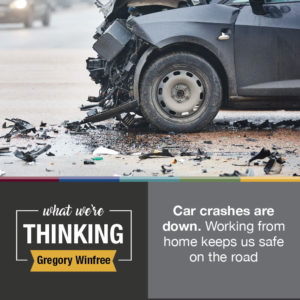No one yet knows how many Americans will die this year from COVID-19. But here’s a pretty safe bet on the number who will die in car crashes: Likely not as many as last year.
Call it an unintended benefit of widespread stay-at-home orders designed to fight the spread of the coronavirus. When people stay at home, whether they’re working or not, their cars and trucks stay at home, too. Personal vehicles don’t crash when they stay in driveways and garages. Consequently, their drivers and passengers don’t end up in hospital emergency rooms (or worse).
That’s a simple truth that we should apply to our road safety agenda long after the current public health crisis is behind us. Even if all we do is implement a more structured and public policy-driven practice of working from home periodically (for those of us who are able to), we can surely reduce the number of roadway crashes with a byproduct of relieving traffic congestion. We shouldn’t need another national public health emergency in order to apply what we’re learning (or re-learning) from this one.
To see what’s possible, just consider the unfolding picture in Houston.
Major freeway traffic volumes in March were half of what they were in the same month last year according to data from Houston’s traffic management system, TranStar. Freeway crashes have dropped by more than half during the same time.
This result linking traffic volume and crashes is as uncomplicated as it is predictable. That’s because crashes are a function of two things – risk and exposure. Risk depends on things like the condition of the road (narrow or wide, wet or dry, etc.) and the condition of the driver (alert or distracted, drunk or sober, etc.). Exposure is determined simply by how much someone drives (vehicle miles traveled). If risk remains unchanged, crash likelihood will go up or down based on the amount of miles traveled.
So, if the amount of travel is cut in half, you can expect that crashes will be reduced by about the same degree. It’s simple arithmetic.
You can also expect that what is happening in Houston will happen in virtually every other urban area in America. Various distinctions may exist from one city or region to another, but the basic realities of traffic and car crashes don’t vary based on geography. INRIX, a traffic data and analytics provider, found that COVID-19 reduced traffic volume nationwide by 30 percent in March. “This research,” according to INRIX, “is likely a preview of what is to come for hundreds of cities across America if the COVID-19 outbreak continues.”
For another example, we can look to the 2008 financial crisis, which was central to a sharp drop in roadway deaths among those under age 24. Limited employment opportunities largely kept that group off the road, reducing their crash exposure in the process.
Receding collision numbers deliver another benefit, as well. A sharp reduction in crash victims helps to conserve finite hospital capacity across the country, which is being tested as health care professionals care for the growing surge of coronavirus patients.
Will we be able to enact work-at-home policies that decrease traffic as much as a pandemic will? No. But that’s not the point. The point is that any meaningful reduction in traffic volume will unquestionably reduce crashes – and their associated deaths and injuries – by a degree that is also meaningful. What constitutes “meaningful reduction?” Just ask anyone who’s been in a crash – or anyone who has lost a friend or family member in one.
Shelter-in-place restrictions may seem onerous (limited freedom) and their justification (a virulent, highly contagious virus) may be frightening, but there’s no denying that those constraints are also highly effective. Complying with the stay-at-home orders will limit the number of people who get sick. Compliance will also limit the number injured or killed in car crashes.
We’ve been relying upon the same general approach to our national crash death crisis for years, but we’re not making enough progress. TTI is developing new methods to help understand and prevent crashes, in part through analyzing new data sources such as vehicle on-board sensor data. What safety experts refer to as the three E’s (engineering, enforcement, and education) will take us only so far in reducing a number that remains stubbornly near 40,000 every year. Perhaps we need another “E” – employment-at-home.
The effect on crashes from widespread shelter-in-place orders to stem the virus outbreak is predictable. And it also makes a legitimate argument for sustaining practical work-from-home protocols even after our national emergency is behind us.
Gregory Winfree is the agency director of the Texas A&M Transportation Institute and a former U.S. assistant secretary of transportation.
This article was originally published in The Houston Chronicle, April 10, 2020.
